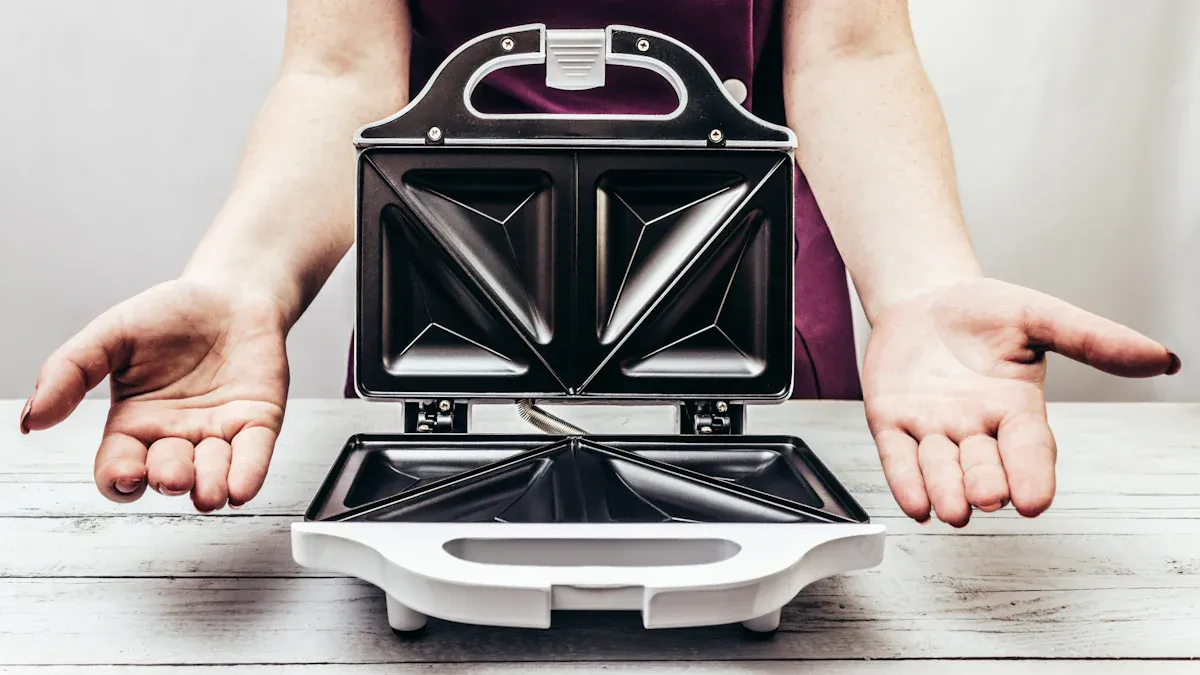
Choosing the right sandwich maker transforms meal preparation into a quick and enjoyable experience. This versatile appliance simplifies cooking by evenly heating food on both sides, saving valuable time. Its compact design fits seamlessly into small kitchens, maximizing counter space. User-friendly controls make it accessible for everyone, while non-stick plates ensure effortless cleaning.
Key Takeaways
- Pick a sandwich maker with 700-1200 watts for fast heating.
- Choose the size that fits your family’s needs. Small ones work for one person, big ones are good for families.
- Get one with non-stick plates. It’s easier to clean and needs less oil for cooking.
Key Features to Look for in a Sandwich Maker

Power and Wattage
The power of a sandwich maker determines its heating efficiency and cooking speed. Models with higher wattage heat up faster, reducing preparation time. For most households, a sandwich maker with 700 to 1200 watts provides an ideal balance between energy consumption and performance. Higher wattage also ensures even cooking, preventing undercooked or burnt sandwiches. When selecting a model, consider your daily usage needs and opt for one that offers consistent heating without excessive energy use.
Number of Slices
The number of slices a sandwich maker can handle directly impacts its suitability for different households. Compact models typically accommodate two slices, making them perfect for individuals or small families. Larger models, designed for four slices or more, cater to bigger households or those who frequently entertain guests. Choosing the right size ensures efficient meal preparation without unnecessary waiting time. Families with varying appetites may benefit from a larger-capacity sandwich maker to meet everyone’s needs.
Plate Surface and Material
The plate surface plays a crucial role in the quality of your sandwiches and the ease of cleaning. Non-stick plates prevent food from sticking, ensuring hassle-free cleanup and perfectly cooked sandwiches every time. Some models feature removable plates, which can be washed separately, adding to their convenience. Durable materials like ceramic or cast iron enhance the longevity of the appliance. A high-quality plate surface not only improves performance but also reduces the need for excessive oil or butter, promoting healthier cooking.
| Feature | Description |
|---|---|
| Versatility | Ability to prepare various meals beyond sandwiches, such as waffles and grills. |
| Ease of Cleaning | Models with removable, nonstick plates for quick and easy cleanup. |
| Durability | Assessed through flexural and impact testing to ensure long-term use. |
| Additional Features | Quick heat-up, stay-cool handles, indicator lights, and automatic temperature control for enhanced user experience. |
| Performance Testing | Involves measuring cooking consistency, heating speed, and usability through standardized methods. |
Adjustable Heat Settings
Adjustable heat settings allow users to customize the cooking process based on their preferences. Whether you prefer lightly toasted bread or a crispy, golden-brown finish, this feature ensures flexibility. It also accommodates different types of bread and fillings, preventing overcooking or undercooking. Models with intuitive heat controls enhance user satisfaction by offering precise temperature adjustments. This feature is especially useful for those who enjoy experimenting with various sandwich recipes.
Handle Design and Safety Features
A well-designed handle ensures safe and comfortable operation. Look for models with stay-cool handles that prevent burns during use. Locking mechanisms on the handle improve safety by keeping the appliance securely closed while cooking. Some sandwich makers also include non-slip feet, which provide stability on countertops. These features reduce the risk of accidents, making the appliance suitable for households with children. Prioritizing safety features ensures peace of mind during everyday use.
Additional Features for Convenience
Modern sandwich makers often include extra features that enhance convenience and versatility. Removable non-stick grids simplify cleaning, while adjustable sandwich thickness settings allow users to create a variety of sandwiches. Some models double as panini presses or grills, expanding their functionality. Easy-to-use controls, such as indicator lights and automatic temperature regulation, improve the overall user experience. These features make the sandwich maker a valuable addition to any kitchen.
- Additional features like removable non-stick grids enhance cleaning convenience.
- Adjustable sandwich thickness settings improve versatility in sandwich making.
- Some models can toast bread, make paninis, or grill vegetables, adding to their functionality.
- Easy-to-use features such as adjustable heat settings and intuitive interfaces significantly enhance user satisfaction.
- Removable lids for easy cleaning are highlighted as a major convenience factor.
How to Match a Sandwich Maker to Your Needs
Family Size and Usage Frequency
The size of your household and how often you plan to use the sandwich maker are critical factors to consider. For individuals or couples, a compact model with a two-slice capacity is often sufficient. These smaller appliances save space and energy while meeting basic needs. Larger families or those who frequently host guests may benefit from a four-slice or even six-slice model. These options allow for quicker meal preparation, ensuring everyone gets their sandwich at the same time.
Frequent users should also prioritize durability and performance. High-quality materials and consistent heating capabilities ensure the appliance can handle daily use without compromising results. Occasional users, on the other hand, might prefer a simpler, more affordable model that still delivers reliable performance when needed.
Budget and Price Range
Setting a budget helps narrow down your options and ensures you get the best value for your money. Sandwich makers come in a wide price range, from basic models under $30 to premium options exceeding $100. Basic models are ideal for those on a tight budget or with minimal needs. They provide essential features like non-stick plates and compact designs.
For those willing to invest more, premium models offer advanced features such as adjustable heat settings, removable plates, and multi-functionality. These appliances often double as panini presses or grills, adding versatility to your kitchen. According to market insights, the home segment dominates the sandwich maker market, driven by the growing trend of in-home meal preparation. This trend highlights the importance of choosing a model that aligns with your cooking habits and financial priorities.
| Aspect | Details |
|---|---|
| Market Value in 2025 | Estimated at $2.5 billion |
| Projected Market Value in 2033 | Approximately $3.5 billion |
| CAGR (2025-2033) | 5% |
| Key Drivers | 1. Demand for quick meal preparation methods |
2. Health-conscious eating trends
3. Diverse range of models available |
| Dominant Segment | Home segment, driven by in-home meal preparation trends |
Space and Storage Considerations
The size and design of your kitchen play a significant role in selecting the right sandwich maker. Compact models are perfect for small kitchens or limited counter space. Their lightweight design also makes them easy to store in cabinets or drawers when not in use. For larger kitchens, bulkier models with additional features may be a better fit.
Efficient storage solutions can further enhance convenience. Vertical storage options, such as models with cord wraps or upright designs, save space and keep your kitchen organized. Ergonomic designs also reduce clutter and improve accessibility. By considering your kitchen layout and storage needs, you can choose a sandwich maker that integrates seamlessly into your space.
Versatility for Different Sandwich Types
A versatile sandwich maker opens up a world of culinary possibilities. Many models feature adjustable heat settings and removable plates, allowing users to experiment with various bread types and fillings. From classic grilled cheese to gourmet paninis, the right appliance can handle it all. Some models even include browning controls, ensuring the perfect toast level for every sandwich.
Additional features, such as 2-in-1 functionality, further enhance versatility. These appliances can switch between a sandwich maker and a panini press, catering to diverse recipes. Compact designs also accommodate larger sandwiches, making them suitable for hearty meals. With these capabilities, a sandwich maker becomes more than just a kitchen gadget—it transforms into a tool for creativity and convenience.
- Models with adjustable heat settings cater to different fillings and bread types.
- Removable plates support various cooking methods, including grilling and pressing.
- Browning controls and customization features expand the range of sandwich options.
- Compact designs fit easily on countertops while accommodating larger sandwiches.
Tip: Look for a sandwich maker with multi-functionality to maximize its value. A versatile appliance not only saves time but also encourages healthier, homemade meals.
Tips for Using and Maintaining Your Sandwich Maker

Preheating for Optimal Results
Preheating a sandwich maker ensures even cooking and enhances the texture of your sandwiches. Before placing the bread and fillings, users should allow the appliance to reach its optimal temperature. Most models include an indicator light that signals when preheating is complete. Skipping this step can lead to unevenly toasted bread or undercooked fillings. By preheating, users can achieve a crisp, golden-brown finish every time. This simple habit also reduces cooking time, making meal preparation more efficient.
Proper Sandwich Assembly
The way a sandwich is assembled impacts its taste and cooking outcome. Users should evenly distribute fillings to prevent spillage and ensure consistent heating. Placing cheese near the bread helps it melt evenly, while spreading butter or oil on the outer sides creates a deliciously crispy crust. Overloading the sandwich can cause uneven cooking or messes inside the appliance. A balanced approach to assembly guarantees a satisfying result with minimal cleanup.
Cleaning and Maintenance
Regular cleaning keeps a sandwich maker in top condition and extends its lifespan. Non-stick plates should be wiped with a damp cloth after each use to remove residue. For stubborn stains, a soft sponge and mild detergent work well. Removable plates, if available, can be washed separately for added convenience. Avoid using abrasive materials that may damage the surface. Proper maintenance ensures the appliance remains hygienic and ready for the next use.
Safety Tips for Everyday Use
Safety should always be a priority when using a sandwich maker. Users should place the appliance on a stable, heat-resistant surface to prevent accidents. Handles designed to stay cool during operation reduce the risk of burns. It’s important to unplug the device after use and allow it to cool before cleaning. For households with children, keeping the appliance out of reach adds an extra layer of safety. Following these precautions ensures a worry-free cooking experience.
Choosing the right sandwich maker enhances convenience and satisfaction. Key features like power, non-stick plates, and adjustable heat settings improve usability and cooking results. Matching these features to your lifestyle ensures a perfect fit.
| Feature | Importance |
|---|---|
| Power of the Sandwich Toaster | High power (700-750 watts) ensures quick heating, saving time for busy consumers. |
| Number of Slices | Options for 2 or 4 slices cater to different family sizes, enhancing usability. |
| The Surface of the Plate | Non-stick surfaces prevent sticking and ease cleaning, contributing to user satisfaction. |
| Adjustable Heat Settings | Allows customization of crispiness, improving the cooking experience for users. |
| Type of Handle | Ergonomic and heat-resistant handles enhance safety and usability for daily use. |
Investing in a sandwich maker tailored to your needs guarantees a better cooking experience. Make your choice confidently and enjoy delicious homemade sandwiches every day!
FAQ
What is the ideal wattage for a sandwich maker?
A sandwich maker with 700-1200 watts offers the best balance of energy efficiency and performance. Higher wattage ensures faster heating and evenly cooked sandwiches.
Can a sandwich maker handle thick sandwiches?
Yes, many models include adjustable thickness settings. These allow users to prepare sandwiches with thicker bread or generous fillings without compromising cooking quality.
How do I clean a sandwich maker with non-stick plates?
Wipe the plates with a damp cloth after each use. For stubborn stains, use a soft sponge and mild detergent. Avoid abrasive materials to protect the surface.
Tip: Always unplug and cool the appliance before cleaning to ensure safety and maintain its longevity.

